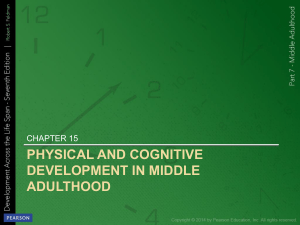Chapter 15 as PowerPoint
advertisement
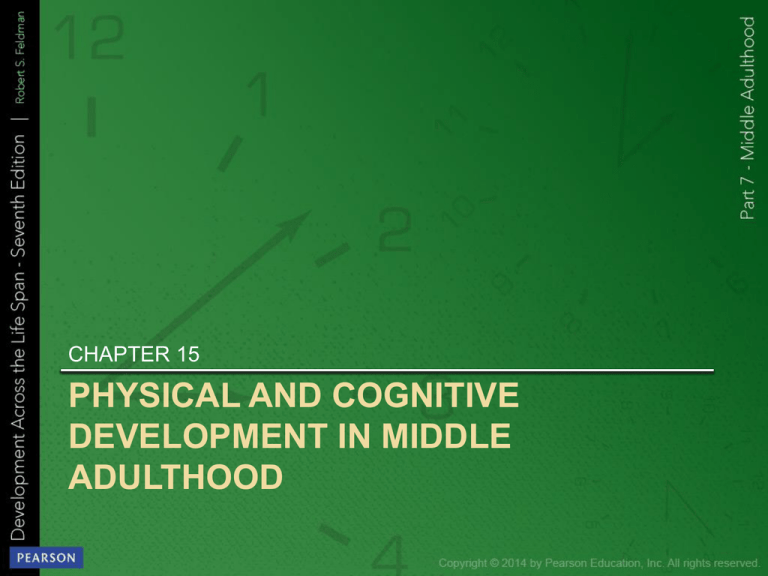
CHAPTER 15 PHYSICAL AND COGNITIVE DEVELOPMENT IN MIDDLE ADULTHOOD PHYSICAL DEVELOPMENT Age Changes • What stays the same as we age? • What changes with age? Physical Transitions in Middle Adulthood • Definition: Time when most people first become aware of gradual changes in body that mark aging process. • Gradual psychological and emotional changes in body's capabilities • Reactions depend in part on self-concept and lifestyle • Aging Signs signal • A reduction in physical attractiveness • Aging • Mortality Additional Material There was an old lady…. Society applies a double standard to men and women in terms of appearance • Older women tend to be viewed in unflattering terms • Not as true of high status women • Not as true of healthy, slim women • Highly dependent on grooming, dress, ‘presentation’ • Aging men more frequently perceived as displaying maturity that enhances status • True of high status individuals • Not so true of low status individuals • Highly dependent on grooming, dress, ‘presentation’ Additional Material Height, Weight, and Strength: Benchmarks of Change • After age 55, bones become less dense – Ultimately women lose 2 inches and men lose 1 inch in height • Women at risk of osteoporosis due to lack of exercise (not inadequate calcium) • People continue to gain weight in middle adulthood – body fat tends to grow in average person – Physical decline due to lack of exercise accelerates • Strength • Strength gradually decreases particularly in the back and leg muscles. • By 60, people have lost, on average, about 10 percent of their maximum strength Additional Material Sights and Sounds of Middle Age • Starting at age 40, visual acuity declines – Changing eye's lenses in shape & elasticity results in loss of near vision, called presbyopia • Glaucoma Risk • Lens clouds – Night vision – Glare – Depth perception Additional Material Do you hear what I hear? PRESBYCUSIS - lose hearing sounds of high frequency – About 12 percent of people between 45 and 65 – Men more prone to hearing loss – Changing as women enter former male jobs – Eardrum becomes stiffer – Hair cells die • Sound localization is diminished – Differential loss – High frequencies are better localized Additional Material Reaction time: Not-so-slowing Down • Decreases slightly in middle adulthood • Improves or compensated for by being more careful and practicing the skill • Lifestyle choices like exercise can slow this loss • Predictive responses increase in accuracy which compensates “Use It or Lose It” Additional Material Sex in Middle Adulthood: The Ongoing Sexuality of Middle Age Sexuality remains an important part of life for most middle-aged people •Frequency of sexual intercourse decreases with age – (in many but not all couples) – Sexual activities remain a vital part of most middleaged adults’ lives – Adults have more freedom & privacy – Women no longer need to practice birth control (after menopause) – Sexual Intercourse Both men and women can face some challenges to their sexuality during middle adulthood • Men typically need more time to get an erection – Volume of fluid in ejaculation declines – Production of testosterone also declines • In women, walls of the vagina become less elastic and thinner – Vagina shrinks, potentially making intercourse painful Frequency of Sexual Intercourse Female Climateric • Starting about age 45, transition from being able to bear children to being unable to do so • Perimenopause is period beginning around 10 years prior to menopause when hormone production begins to change • Production of estrogen and progesterone drop • Process may begin as early as 40 or as late as 60. • Lasting about 15 to 20 years • Menopause • Symptoms such as "hot flashes," headaches, feeling dizzy, heart palpitations, and aching joints are common during menopause. • Half of women report no symptoms at all. Additional Material Menopause & ERT Estrogen replacement therapy (ERT) • Women's expectations about menopause relate to their experience of menopause – Variations by race and culture • Estrogen replacement therapy (ERT), symptoms are alleviated and variety of problems are reduced, such as: • Osteoporosis • Heart disease • Colon cancer • Stroke • Skin elasticity • Risks associated with ERT. • Breast cancer • Abnormal blood clots • Cancer of the uterine lining The Dilemma of Hormone Therapy Estrogen and progesterone used to alleviate menopausal symptoms: Early findings PRO • Changes ratio of “good” cholesterol to “bad” cholesterol • Decreases thinning of bones • Associated with reduced risks of stroke and colon cancer • Cognitive advantages • Enhances sex drive CON • Increases risk of breast cancer and blood clots • Higher risk for pulmonary embolism and heart disease And So… • Results of the Women's Health Initiative study led to a profound rethinking of the benefits of HT – Questions if HT could protect postmenopausal – women against chronic disease • Many women stopped taking hormone replacement drugs – 40 percent of postmenopausal women in the U.S. were using hormone therapy in 2002 – 20 percent a decade later • Most recent thinking among medical experts is that it's not a simple all-or-nothing proposition – Some women are simply better candidates for HT than others Additional Material Menopause - ERT • • • • Huge controversy Study results contradictory Large ethnicity differences Current recommendation is use only for – Highly adverse symptoms – Short period – Low doses • Major flaws in virtually all studies – Premarin (Equine hormone) 90% of studies • Not a good match for human estrogen • Not a very ‘pure’ extract – No control (or testing) for hormone mimics – High dosages (usually) Menopause Psychological Effects • About 10 percent of women have psychological issues • Depression • Anxiety • Crying spells • Lack of concentration • Irritability • It is now believed that women's expectations about menopause relate to their experience of menopause. • Exercise plays a role • Stress plays a role • Overall health apart form aging plays a role • Indian women have few symptoms and look forward to the social advantages of being past the childbearing age. • Mayan women also have few symptoms and look forward to the freedom of being past childbearing age. The Psychological Consequences of Menopause • Early research – Menopause was linked directly to depression, anxiety, crying spells, lack of concentration, and irritability • Current research – Normal part of aging that does not, by itself, produce psychological symptoms • Effects influenced by personal and cultural expectations of menopause Do men experience the equivalent of menopause? Additional Material Male Climacteric • Male changes during middle age – Period of physical and psychological change relating to male reproductive system that occurs during late middle age. – Enlargement of the prostate gland (age 40 ~ 10%) – Problems with urination, including difficulty starting to urinate and frequent need to urinate during night (Freq. of occurrence increases but it is NOT common) • Men still produce sperm and can father children through middle age Additional Material Male Climacteric Psychological • Career concerns • Some men experience body image issues – Sports prowess declines – Very active men • Knee problems • Muscle injuries increase • Pain perception changes w/ lower testosterone – Belly fat increases • Increased risk of depression – Body image – Lower testosterone HEALTH Complete the following sentences: • Middle-aged people like to ____. • Middle-aged people get annoyed by ____. • Middle-aged people's health is ____. • Middle-aged people's cognitive abilities are ____. • The societal stereotype about middle age indicates____. Been there, Done that, Have the immunity! • Fewer accidents and infections • More careful • More practiced • Have built up immunities over their life • People between the ages of 45 and 65 are less likely than younger adults to experience • Infections • Allergies • respiratory diseases • digestive problems. What do Middle Adults Worry About? • As people enter middle adulthood, health and safety concerns become increasingly important, followed by financial worries. (Source: USA Weekend, 1997.) • Humans poor at ‘risk assessment’ • Middle adulthood doesn’t improve ability • High visibility events seen as more likely while actual high probability events may be seen as less likely. Worries of Adulthood Additional Material Chronic Diseases in Middle Adulthood • Arthritis typically begins after age 40 NOTE: author means RA (Rheumatoid Arthritis) Other types of arthritis have different onset ages • Diabetes is most likely to occur in people between the ages of 50 and 60 NOTE: Author means Type 2 Diabetes. Adult Onset Diabetes is likely a result of excess body fat. As is Insulin resistant Diabetes. • Hypertension (high blood pressure) is one of the most frequent chronic disorders found in middle age • Obesity Adult Preventive Health-Care Screening Recommendations Adult Preventive Health-Care Screening Recommendations Adult Preventive Health-Care Screening Recommendations Additional Material Gender Differences • During middle age, women experience more non-life threatening illnesses than men but men experience more serious illnesses – Women smoke less; drink less alcohol; have less dangerous jobs (Historically. But this is changing) – Men were exposed to more environmental chemicals – Men are more likely to have served in the military • Medical research has typically studied diseases of men the medical community is only now beginning to study women's health issues Individual Variation in Health: Ethnic and Gender Differences Variations • In middle age, African Americans death rate is twice that of Caucasians • Lower family's income higher likelihood of • disabling illness • more dangerous occupations • inferior health coverage • When whites and African Americans of the same SES level are compared, the death rate for African Americans falls below that of Caucasians. August 2013, more than 14 million Americans were receiving disability benefits Disability and Income Level Data skewed by fraud. Link In Stanville, Kentucky, a poor area of US, 10 to 15 percent of the population receives disability payments Stress continues to have a significant impact on health during middle adulthood, as it did in young adulthood, but the nature of what is stressful may have changed. Psychoneuroimmunologists Consequences of stress in middle adulthood Stress produces three major consequences: direct physiological effects, harmful behaviors, and indirect health related behaviors. (Source: Adapted from Baum, 1994.) True or False? Heart and circulatory disease in middle age are responsible for more loss of work and disability days due to hospitalization than any other cause. True ! Each year heart and circulatory diseases kill around 200,000 people under the age of 65. The A's B's of Coronary Heart Disease: Linking Health and Personality More men die in middle age of diseases of the heart and circulatory system than any other cause. • Both genetic&experiential characteristics are involved • Heart disease runs in families • Men are more likely to suffer than women, and risks increase with age • Women are less vulnerable, but not immune • Women less likely to recognize heart attack, less likely to get emergency care, and less likely to be properly treated Additional Material Heart Disease and Behavior • There are several environmental and behavioral factors. • Cigarette smoking • High fat and cholesterol in diet (Perhaps not so much) • Lack of physical exercise (Likely the big factor) • Evidence suggests that some psychological factors are also related to heart disease. – The old: Type A personality – Newer: Psychosocial stress – Latest Behavioral Cardiology Risk Factors for Heart Disease Figure 15-7 Death from Heart Disease Worldwide The risk of dying from cardiovascular disease differs significantly depending on the country in which one lives. What cultural or environmental factors might help to explain this fact? (Source: Lloyd-Jones et al., 2009.) The Threat of Cancer Cancer associated w/ genetic & environmental risks • Poor nutrition, smoking, alcohol use, exposure to sunlight, exposure to radiation, and particular occupational hazards • Early treatment is related to higher survival rate – 40 percent of people diagnosed with the disease are still alive 5 years later – second leading cause of death in US. • Therapy: radiation, chemotherapy, surgery • Detection: breast exam, mammogram, testicle exam Cancer Treatment Treatment • Takes a variety of forms – Radiation therapy involves the use of radiation to destroy a tumor – Chemotherapy involves the controlled ingestion of toxic substances meant to poison the tumor • Surgery may be used to remove the tumor • Early diagnosis is crucial • But ‘success’ may be only in treatment of Cancers that would have never been life threatening Breast Cancer • Mammography, a weak X-ray, is used to detect breast cancer • Death rate lower for those who had a "fighting spirit" or those who denied they had the disease • A positive psychological outlook may boost the body's immune system Breast Cancer Incidence and Age Figure 15-8 Age and the Risk of Breast Cancer Starting around the age of 30, the risk of breast cancer becomes increasingly likely (Source: Based on data from the American Cancer Society, 2003.) Mammograms have become controversial Additional Material Mammograms. A mixed blessing? Despite substantial increases in the number of cases of early-stage breast cancer detected, • Screening mammography has only marginally reduced the rate at which women present with advanced cancer. • Although it is not certain which women have been affected, the imbalance suggests that there is substantial over diagnosis – accounting for nearly a third of all newly diagnosed breast cancers • screening is having, at best, only a small effect on the rate of death from breast cancer. New England Journal of Medicine, 2012 http://www.nejm.org/doi/full/10.1056/NEJMoa1206809 COGNITIVE DEVELOPMENT Additional Material Does intelligence decline in middle adulthood? Difficulties in answering this question may be tied to research methodologies. Difficulties in Answering the Question Older research Newer research • Cross sectional studies • Cohort effect • Longitudinal studies • Practice effect and participant attrition Additional Material Cognitive Development Cross-sectional studies • Older subjects scored less well than younger subjects on traditional IQ tests – Intelligence peaks at 18, stays steady until mid-20s, and declines till end of life – suggest decline with age in IQ scores may underestimate intelligence in older subjects due to cohort effects. Better stated as the Flynn Effect – For a detailed treaties see this link Longitudinal studies • Different developmental patterns in intelligence – Stable and even increasing IQ scores until mid-30s and some to mid-50s, then declined Complicating the Issue Further: What about the Kinds of Intelligence? • Fluid intelligence is the ability to deal with new problems and situations • Fluid intelligence is inductive reasoning, spatial orientation, perceptual speed, and verbal memory. Fluid intelligence does decline with age. Complicating the Issue Further: What about the Kinds of Intelligence? Cont. • Crystallized intelligence is the store of information, skills, and strategies that people have acquired through education and prior experiences, and through their previous use of fluid intelligence • Crystallized intelligence includes numerical and verbal abilities, such as solving a crossword puzzle or a mathematical problem. • Crystallized intelligence holds steady or increases with age. The Answer-Maybe • When developmentalists looked at the two kinds of intelligence separately, a new answer appears to the question of whether intelligence declines with age • There are two answers: yes and no – Yes, because in general, fluid intelligence does decline with age – No, because crystallized intelligence holds steady and in some cases actually improves Even though scores on IQ tests decline with age, middle-aged people show no decline in general cognitive competence. Traditional tests may not tap into practical intelligence. Changes in Crystalized and Fluid Intelligence One More Explanation: Schaie (1994) • Many particular types of ability, such as spatial orientation, numeric ability, and verbal ability, rather than the broad divisions of crystallized and fluid intelligence • When considered this way – Certain abilities, such as inductive reasoning, spatial orientation, perceptual speed, and verbal memory, begin to decline very gradually at around age 25 and continue to decline through old age – Numeric ability tends to increase until the mid-forties, is lower at age 60, and then stays steady throughout the rest of life – Verbal ability rises until about the start of middle adulthood, around age 40, and stays fairly steady throughout the rest of the life span Continued Competence during Gradual Decline: Why? Salthouse suggests four reasons why this discrepancy exists: Additional Material Highly Successful Middle-Aged People • Highly successful middle-aged people may not be representative of all middle-aged people. • Professional success may not rely exclusively on cognitive ability. (DUH!) • Older, successful people may have developed expertise in their particular occupational area (DUH 2!) • Or be successful due to SELECTIVE OPTIMIZATION, the process by which people concentrate on particular skill areas to compensate for losses in other areas. Additional Material The Development of Expertise: Separating Experts from Novices Expertise is the acquisition of skill or knowledge in a particular area, develops as people devote attention and practice • Expert = rely on experience and intuition, process information automatically, use different neural pathways to solve problems • Operate on Principles • Novice = strictly follow formal rules and procedures, use better strategies and better problem-solving • Operate on Rules Because experts have so much experience, their behavior is often automatic, performed without much thought. What Is Multitasking Doing to Our Brains? Multitaskers versus Non-multitaskers • Multitaskers may be oversensitive to incoming information (Ophir, Nass, & Wagner, 2009) • Middle-aged adults with internet searching experience show higher levels of brain activation when searching than those reading pages of text – Suggests development of new neural pathways involved in decision-making and reasoning • People with considerable experience playing video games actually become better at reacting to stimuli, singling out important information, and switching between tasks Additional Material What IS Clear about Multitasking • Certain kinds of tasks are inherently difficult to carry out simultaneously, such as driving and texting: • A considerable body of research shows that it can't be done safely! • Multitasking leads to poorer results on most tasks (Except parallel tasks which has confused researchers) Memory: You Must Remember This According to research on memory changes in adulthood • Most people show only minimal losses • Many exhibit no memory loss in middle adulthood Memory is viewed in terms of three sequential components • Sensory memory • Short-term memory holds information for 15 to 25 seconds • Long-term memory Additional Material Memory • Memory has three sequential components. – Sensory memory is an initial, momentary storage of information that lasts only an instant. • No decline in middle age. – Short-term memory holds info for 15 to 25 seconds. (can be refreshed) • No decline in middle age. – Long-term memory holds info relatively permanently. • Some decline in middle age. Storage is less efficient (?) • A reduction in efficiency of memory retrieval (?) • Storage contains more Schemas in Middle Adulthoodorganized bodies of information stored in memory. Schemas: organized bodies of info stored in memory. People hold schemas for particular individuals as well as for categories of people and behaviors or events • Help people represent the way the world is organized • Aid in categorization & interpretation of new information • Convey cultural information • organize their behavior into coherent wholes • help to interpret social events Additional Material Effective Strategies for Remembering • Mnemonics: formal strategies for organizing material in ways that make it more likely to be remembered. • Get organized • Develop intentional habits • Pay attention • Use encoding specificity phenomenon Recall easier when more factors are the same • Visualize • Rehearse • Say it out loud • Share with someone else
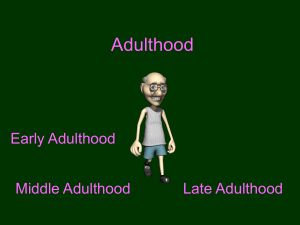
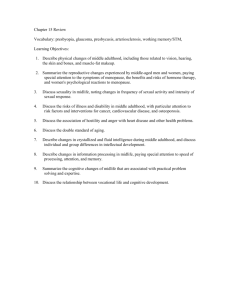
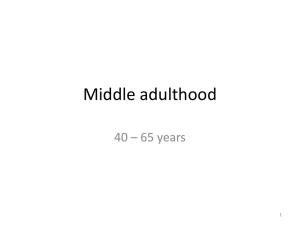
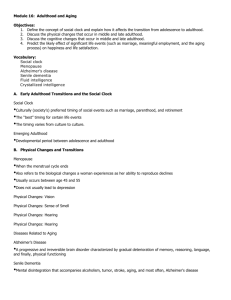
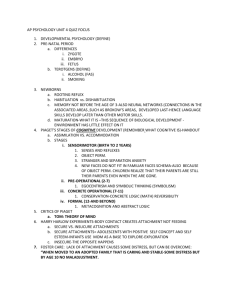
![Adulthood andaging[1]](http://s3.studylib.net/store/data/009423432_1-4447cad1799ab03eaf7339901cd9d417-300x300.png)

